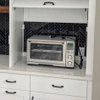DW and calcification
I know this has been covered a thousand times. I still don't get it.
Y'all have schooled me about them "enzymes" in the newfangled dishwasher soap. I don't get how they can be "deactivated", and don't get how they work.
So the repairman who graced our abode recently told me that moisture is the death of the enzymes in the detergent. He puts his in a ziplock he says, to keep it dry. If it's old it's unlikely to be working any longer because it's likely to have absorbed moisture.
From my little knowledge of chemistry, I suppose that's vaguely plausible. But there are real live chemists on this site and thought I'd ask for some enlightenment. I am guessing it's a trade secret what these "enzymes" actually are. But it would be nice to know.
Here's what really confuses me - the contention that these things need 'food on the plate' in order to "work". And if the food isn't there then the plate will be etched preferentially.
So -- how does this work??? You're supposed to rinse the food particles from the plates, the pieces, but leave a film of slime? What if there is none? What about water glasses? What if there's something that needs scrubbing, say, lipstick? Why does some sticky food actually seem to get dealt with surprisingly well and others not - e.g., egg in my machine (KA KUDE series) works amazingly well, caked on and annealed as it seems to be. Fruit goo from smoothies does not. You have to rub every mm of that stuff away; the DW just doesn't get rid of it. But why not? What about those fabled "enzymes"?? And that stuff isn't terribly obviously sticky the way, say, egg is ... I don't get it.
How do I know that the enzyme is water-saturated and that's the reason for its failure? When I look at my detergent I see fewer of those little colored bits. Were those the enzymes? Do they lose their color when "deactivated"?
Etching. I totally don't get this either, and also what the difference is between this and calcification.
So it's been said on this forum that if you place plates and glasses in too clean, the enzymes will start to 'eat away at' the crockery because, um, there's no food around for them to "digest". This seems bizarre to me in light of, for example, the fact that these enzymes seemingly do nothing to, say, smoothie goo (see above).
Moreover, my glasses, which are all now incredibly cloudy, seem instead to have a really hard-but-not-impossible film of calcified water on them. With the blue-scrubby side of a sponge I can get it off. It takes some elbow grease, but the glass comes out OK, seemingly not "etched". Which makes sense to me, though is in opposition, maybe, to claims from this forum. I say "maybe", because it could be that other conditions would actually etch the glassware still, and I don't have these. So there's a sort of "convergence" of symptoms, if you will -- namely, cloudy glassware. I seem to have it from calcification, but that doesn't mean, say, that 'etching' isn't possible as well.
The repairer who was here recommended purchasing a product from Home Depot that you run in the machine alone, comes in a cup size with a wax seal which dissolves on running the machine and will scrub away at the calcification. The buildup in my machine is *considerable*. He doubts it can really be cleaned out, it's so bad. But he said to give that product a try. However when I go to HDespot I can't find it. There are tablet thingies designed to go not in the tray but in the soap cup and can be used with dishes -- is that a different product? Less heavy-duty? Does anyone know what the other one might be? Does anyone know whether it's useful and/or likely to be effective?
Is there an alternative to "product" to melt away the calcification? What is "like" (as in "clean like with like") calcium or magnesium? that I could use to clean the machine directly rather than through product?
Also stated here and reiterated by Mr Repairman is that I *need* another product, that JetDry. I tried to explain to him that quite frankly, I couldn't care less if my dishes come out of the machine squeaky-dry. Honestly, with the amount of work that needs doing around here and the backed-up schedules of it, opening a DW and letting it all air-dry for an hour is just not a problem.
But the claim's been made here that the JetDry is necessary to ward off the "etching" and/or calcification.
To which I say grump and double-grump. I don't like being up-sold on all this "product". What's wrong with a pinch of soap and water?
OTOH, something's wrong, way-wrong. Still. And I bet that super-fine meshed filter in my machine is itself seriously clogged just with calcified deposits I can't even see and that in itself diminishes the effectiveness of the machine. So I'm guessing at least buying some product to set me back near to square one would be necessary....
Can anyone help me please? I know this is a ton of questions and even more complaining -- sorry?! I guess along with a machine that's unbelievably quiet comes a new set of requirements and I should be grateful for what I've got and recognize it comes with a price. Still.... ;)
TIA!!!




User
aliris19Original Author
Related Discussions
Diswasher Won't Fill, Ideas
Q
Any good reason not to choose a SpeedQueen FL?
Q
Vinegar in the wash?
Q
Hard water and tankless W/Hs
Q
weissman
aliris19Original Author
weissman
dadoes
aliris19Original Author
dadoes
weedmeister
sjerin
relic
dadoes